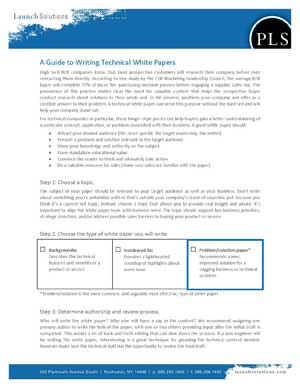Launch Team offers new AI and GEO Assessment
Get a Competitive Edge with Comprehensive AI & GEO Insights If you are beginning to notice an erosion in organic traffic and leads, it may be time to...
4 min read
Katie Steelman Thu, Apr 24, 2014

 Because we work primarily with high tech companies whose differentiation is their technology, sometimes at the hair-splitting level, we wade in the sea of technical content every day. For the non-engineer, -mathematician, or -scientist, a content marketing strategy seems like a fool's game. A variety of literature suggests approaches to engage employees and to get the most from your high tech company’s technical staff to help develop the excellent content that marketers use to generate qualified leads. There are some very good suggestions, but here’s the rub:
Because we work primarily with high tech companies whose differentiation is their technology, sometimes at the hair-splitting level, we wade in the sea of technical content every day. For the non-engineer, -mathematician, or -scientist, a content marketing strategy seems like a fool's game. A variety of literature suggests approaches to engage employees and to get the most from your high tech company’s technical staff to help develop the excellent content that marketers use to generate qualified leads. There are some very good suggestions, but here’s the rub:
It happened just the other day. One of our clients made it a priority and took the time to develop content, but when abstracts for white papers were submitted for internal review, they found that clarity was a big gap. These are very smart engineers and scientists, but they needed a bit of structure and coaching to get them moving in a constructive direction when authoring the white papers and other technical articles.
We assembled a cheat sheet of tips, questions to answer, and other organizing principles.
Download these tips for your own technical content writing.
White papers can be presented in a few different ways; the can be used to describe the technical features and benefits of a product or service in detail or to provide a roundup of highlights about a current industry issue. The most common, and arguably most effective, type of white paper presents a pressing business or technical problem and proposes a solution. A good white paper will outline:
Without pushing your particular product or company too heavily, your white paper should be able to convince people that a) this is a problem that does or will affect them, b) the problem requires a solution, and c) they should seriously consider your solution. Your reasoning should be focused on the type of solution or approach you are advocating, with your specific product or service mentioned secondarily.
The language and details you include in your white paper will depend on the type of people you want to read it. Think about your intended audience. Are they engineers? Buyers? Program managers? CEOs? What are their main motivations for investigating your company or product? An engineer or technician might want to learn about the technical or practical considerations of a problem-solution, while a program manager might be more interested in how a particular approach saves costs or reduces program risk.
The way you present the information will also vary based on who’s reading it; for example, graphs and technical diagrams would appeal to engineers, while other audiences might prefer anecdotes or case studies that illustrate how a solution has worked in application. Whomever you choose to write for, narrowing your audience will help you create content that people want to read and share.
A good white paper stands on its educational merits alone. Your white paper suggests a solution to a problem that your audience or industry might be facing, and while it is acceptable and expected to mention your product or service, pushing your brand too hard can overwhelm or invalidate the quality advice you are giving. Therefore, it is generally a good idea to either:
All readers appreciate a well-composed and easy to navigate layout. Going overboard with charts and graphs or cramming too much info into your white paper will work against the intended goal. We suggest:
Finally, will your white paper ultimately drive a specific goal? Will it generate website visits, inquiries for your products and services, or the desire to learn more? The white paper isn’t a brochure, but it is acceptable to have a clear call to action encouraging readers to take the next step.
Launch Team helps small and mid-sized companies focused on high tech, engineering services, advanced materials, instrumentation and other science-based disciplines attract and convert leads to sales through inbound and outbound marketing strategies. We approach content marketing by following many of the common best practices, yet we also get into the technical weeds most marketers shun.
We employ engineers who have a knack for writing. They can role their sleeves up with your technical staff, which accelerates the content development process, requires less time from your staff, and ensures best practices are followed. Request a free consultation to learn how we’re different.

Get a Competitive Edge with Comprehensive AI & GEO Insights If you are beginning to notice an erosion in organic traffic and leads, it may be time to...

Updated on 6/10/24 The 80/20 rule or Pareto principle, is a long-standing business strategy that a lot of companies are applying right now to...

CES, Photonics West, and other industry trade shows are just around the corner. Deciding how you will collect and manage leads is an important part...